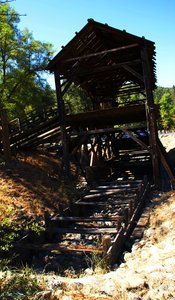Advertisement
Published: December 20th 2012

 SUTTER'S MILL
SUTTER'S MILL
Coloma is on Hwy 49 about seven miles nortwest of Placerville. SUTTER’S MILL
John Sutter, that old criminal, came to California in 1839 by way of Switzerland, Missouri, New Mexico, Oregon, the Sandwich Islands and Sitka. Along the way he abandoned a wife and five children back in Europe and skipped out on every bill he owed. To finance his travels he stole from his partners the proceeds from a trading venture to Santa Fe. He was a fine entrepreneur. California has always been proud of him. He became a citizen of Mexico and somehow finagled an extensive land grant from the Mexicans on land in the Sacramento Valley that the Mexicans had no use for and no legitimate claim to. He went on his merry way to develop his bogus holdings, and the Mexicans were glad to see him go. They hoped he would get eaten by a bear someplace in those remote lands and be heard from by them nevermore again. Sutter built a fort at the confluence of the Sacramento and American Rivers, although back then the American River was probably called something else. The fort is about the only thing he ever built on his land grant. He wasn’t exactly rolling in money. As settlers arrived he would direct them to an area with good soil and water, but they had to build their own farms and pay him a share for the use of land. Eventually he acquired means for a comfortable living without ever lifting a finger in honest toil. James Marshall was a carpenter and millwright who showed up at Sutter’s Fort in 1845 and set off to become a share cropper like everyone else, but he was not a farmer. Marshall joined the Bear Flag Rebellion to overthrow Mexican tyranny and when he returned his farm was a shambles. Sutter had the sense that his land grant, New Helvetia, would not hold up outside of Mexican rule so he began to seek out other opportunities. He and Marshall ventured into a sawmill partnership. Marshall was expected to do all of the work, as usual, and Sutter would sell the lumber. The sawmill was built on the south fork of the American River on property that neither one of them owned. As it neared completion Marshall wanted to test it to be sure the millrace carried enough water to turn the water wheel that operated the saw. He found that it needed a little more digging. When he tested it again he found gold nuggets in the tailrace. The discovery of gold at Sutter’s Mill was an event that when it became known changed history. The California Gold Rush caused explosive growth, immense wealth, and brought about a war with Mexico that resulted in the acquisition of California and the entire southwest. No single event ever had a larger impact on the forging of our nation. Sutter was right. His land claims to New Helvetia didn’t hold up and he moved to Pennsylvania and died broke in 1880. The town of Coloma sprang up around the sawmill as a mining center. Ironically the mill never produced much lumber. Nobody wanted to work it when there was so much gold to be found nearby. The photo shows a reproduction of the mill. The millrace where the gold was exposed that washed into the tailrace is in the foreground.
Advertisement
Tot: 0.223s; Tpl: 0.011s; cc: 12; qc: 47; dbt: 0.1198s; 1; m:domysql w:travelblog (10.17.0.13); sld: 1;
; mem: 1.1mb

 SUTTER'S MILL
SUTTER'S MILL